 |
 |
|
 |
|
 |
|  |
|  |
|
 |
|
 |
|  |
|  |
|
 |
I was wondering what the next simplest shape similar to a moebius trefoil
would be. It's fairly easy to make a 5-lobed knot similar to the 3-lobed
trefoil, but my attempts to produce something with four lobes tended to
produce structures that consisted of two loops with various degrees of
linking between them. Then I happened to create this thing. I'm not sure if
it's a knot or not.
Post a reply to this message
Attachments:
Download 'KnotOrNot.jpg' (79 KB)
Preview of image 'KnotOrNot.jpg'
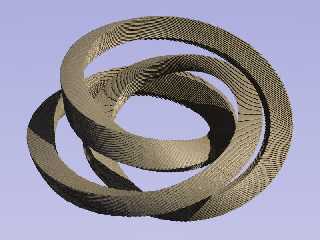
|
 |
|  |
|  |
|
 |
|
 |
|  |
|  |
|
 |
Mike Williams wrote:
> I was wondering what the next simplest shape similar to a moebius trefoil
> would be. It's fairly easy to make a 5-lobed knot similar to the 3-lobed
> trefoil, but my attempts to produce something with four lobes tended to
> produce structures that consisted of two loops with various degrees of
> linking between them. Then I happened to create this thing. I'm not sure if
> it's a knot or not.
I missed somtehing ? s there a knot battle ? where ? wheeeere ? ;-))
Post a reply to this message
|
 |
|  |
|  |
|
 |
|
 |
|  |
|  |
|
 |
> I was wondering what the next simplest shape similar to a moebius trefoil
> would be. It's fairly easy to make a 5-lobed knot similar to the 3-lobed
> trefoil, but my attempts to produce something with four lobes tended to
> produce structures that consisted of two loops with various degrees of
> linking between them. Then I happened to create this thing. I'm not sure if
> it's a knot or not.
Knot Theory - the theroy of knots and their properties - is a complex
but (IMHO) fascinating theory.
One of the topics it deals with is whether to seemingly different
arrangements of string are actually the same knot, arranged into a
different position, or whether they actually *are* different.
In this theory, the simplest knot is the "unknot" or "trivial knot" -
which is simply a closed loop of string. (Not necessarily a circle - you
can actually rearrange it into constructions which *look* like a
different knot. But if you made the thing out of physical string, you
could quickly untangle it.)
Anyway, to determine whether your knot is the unknot or whether it's a
"real knot", you could try computing one of the knot invariants on it...
(Er... or you could wait a few minutes while *I* compute some
invariants! :-S)
The idea of a knot invariant is that no matter how you rearrange the
knot, you can still (fairly) easily compute the invariant from it, and
you will still get the same answer. _However_, that doesn't mean two
totally different knots can't just happen to have the same invariant.
Long story short: if two knots have a different invariant, they are NOT
the same knot. If they have the same invariant, they MIGHT be the same knot.
Now, if you give me a moment, I'll just go Google the Jones polynomial...
Andrew.
Post a reply to this message
|
 |
|  |
|  |
|
 |
|
 |
|  |
|  |
|
 |
my two-cents : two 4-lobed knots and a 3-lobed self-intersecting knot
Post a reply to this message
Attachments:
Download '_tube05.jpg' (13 KB)
Download '_tube04.jpg' (18 KB)
Download '_tube03.jpg' (16 KB)
Preview of image '_tube05.jpg'
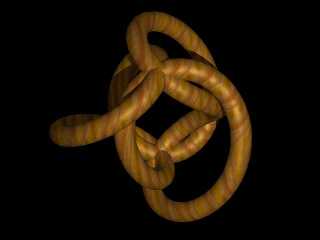
Preview of image '_tube04.jpg'
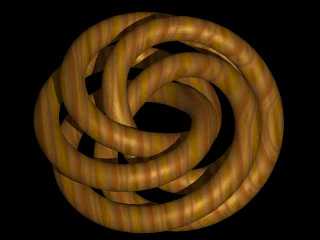
Preview of image '_tube03.jpg'
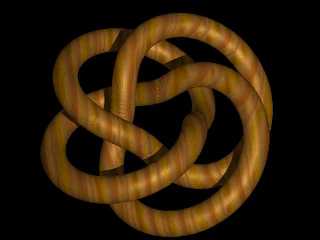
|
 |
|  |
|  |
|
 |
|
 |
|  |
|  |
|
 |
OK, unless I have miscalculated, the Jones polynomial for the knot you
drew obeys
V(t)/t = t + t^(1/2) - t^(-1/2)
which, unless I'm very much mistaken, rearranges to
V(t) = t^2 + t^(3/2) - t^(1/2)
For comparism, the polynomial for the right-trefoil is
V(t) = -t^4 + t^3 + t
For the left-trefoil it is
V(t) = -t^(-4) + t^(-3) + t^(-1)
Most importantly, the Jones polynomial for the unknot is V(t) = 1. The
Jones polynomial for your knot is NOT 1 - therefore your knot is
non-trivial. QED.
Andrew.
Post a reply to this message
|
 |
|  |
|  |
|
 |
|
 |
|  |
|  |
|
 |
LightBeam wrote:
> Mike Williams wrote:
>
>> I was wondering what the next simplest shape similar to a moebius trefoil
>> would be. It's fairly easy to make a 5-lobed knot similar to the 3-lobed
>> trefoil, but my attempts to produce something with four lobes tended to
>> produce structures that consisted of two loops with various degrees of
>> linking between them. Then I happened to create this thing. I'm not
>> sure if
>> it's a knot or not.
>
>
> I missed somtehing ? s there a knot battle ? where ? wheeeere ? ;-))
It is a sixties thing: make love, knot war
Post a reply to this message
|
 |
|  |
|  |
|
 |
|
 |
|  |
|  |
|
 |
> It is a sixties thing: make love, knot war
That's brilliant!
Post a reply to this message
|
 |
|  |
|  |
|
 |
|
 |
|  |
|  |
|
 |
Mike Williams wrote:
> I was wondering what the next simplest shape similar to a moebius trefoil
> would be. It's fairly easy to make a 5-lobed knot similar to the 3-lobed
> trefoil, but my attempts to produce something with four lobes tended to
> produce structures that consisted of two loops with various degrees of
> linking between them. Then I happened to create this thing. I'm not sure if
> it's a knot or not.
>
>
Well, if it's the same as the first knot, below, and I think it is, then
it's a "3,2 Torus Knot" (which I generated using KnotPlot --
http://www.cs.ubc.ca/nest/imager/contributions/scharein/KnotPlot.html )
In which case, using KnotPlot, I deformed it (continuously, so it should
be topologically equivalent) to the second knot, below, which looks
somewhat familiar ;-)
Dave Matthews
Post a reply to this message
Attachments:
Download 'knotview01.jpg' (12 KB)
Download 'knotview02.jpg' (15 KB)
Preview of image 'knotview01.jpg'
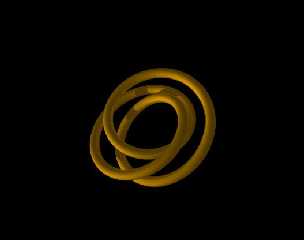
Preview of image 'knotview02.jpg'
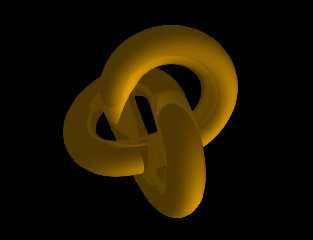
|
 |
|  |
|  |
|
 |
|
 |
|  |
|  |
|
 |
> Well, if it's the same as the first knot, below, and I think it is, then
> it's a "3,2 Torus Knot" (which I generated using KnotPlot --
> http://www.cs.ubc.ca/nest/imager/contributions/scharein/KnotPlot.html )
>
> In which case, using KnotPlot, I deformed it (continuously, so it should
> be topologically equivalent) to the second knot, below, which looks
> somewhat familiar ;-)
OK, now I'm puzzled...
The first image does indeed appear to be the same knot - as far as I can
tell. And yet, you claim it's topologically equivilent to the trefoil
knot. And yet... I computed the Jones polynomial for it, and it's
different to either of the trefoil knots...
Well, one of us has fluffed up somewhere :-S Since the procedure you
undertook is simpler, I suspect it was me :-$
Andrew.
Post a reply to this message
|
 |
|  |
|  |
|
 |
|
 |
|  |
|  |
|
 |
Andrew the Orchid wrote:
>> Well, if it's the same as the first knot, below, and I think it is,
>> then it's a "3,2 Torus Knot" (which I generated using KnotPlot --
>> http://www.cs.ubc.ca/nest/imager/contributions/scharein/KnotPlot.html )
>>
>> In which case, using KnotPlot, I deformed it (continuously, so it
>> should be topologically equivalent) to the second knot, below, which
>> looks somewhat familiar ;-)
>
>
> OK, now I'm puzzled...
>
> The first image does indeed appear to be the same knot - as far as I can
> tell. And yet, you claim it's topologically equivilent to the trefoil
> knot. And yet... I computed the Jones polynomial for it, and it's
> different to either of the trefoil knots...
>
> Well, one of us has fluffed up somewhere :-S Since the procedure you
> undertook is simpler, I suspect it was me :-$
>
> Andrew.
I noticed that, too, but, as you noted, I didn't do anything
mathematical, just clicked "go" and let it tighten itself up (or is it
loosen itself up?) and it quite apparently transformed without ever
disconnecting. I haven't calculated a Jones polynomial since grad
school, which is too many years ago. I best look it up.
Dave Matthews
Post a reply to this message
|
 |
|  |
|  |
|
 |
|
 |
|  |




![]()